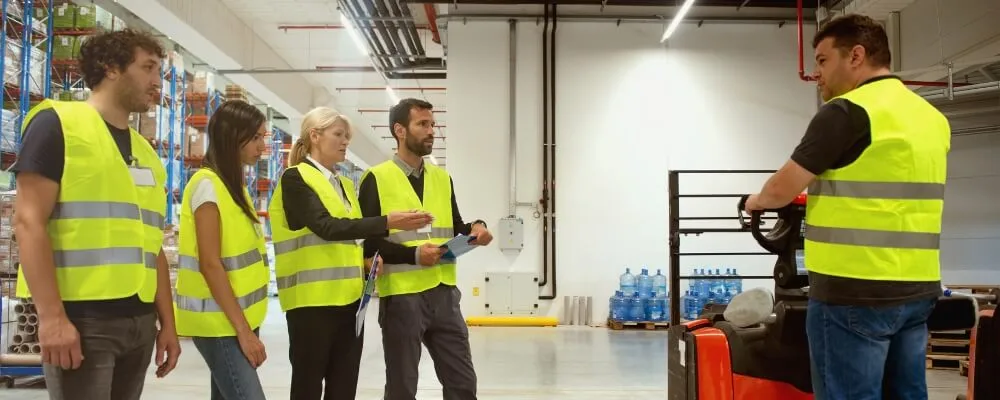In today’s fast-paced industrial and corporate landscapes, the significance of a safe working environment has never been more paramount. But how do businesses ensure that every individual, from a fresh recruit to a visiting contractor, understands the specific safety nuances of a particular workplace? Enter Safety Induction Training. This essential orientation tool lays down the foundational knowledge for newcomers and reinforces the commitment to safety for all stakeholders.
In this comprehensive guide, we delve into the definition of Safety Induction Training, explore its pivotal role in creating a hazard-free workspace, and walk you through its meticulous process. Whether you’re an employer aiming to fortify your company’s safety culture or an employee eager to grasp the essentials of workplace safety, this blog serves as your roadmap. Join us as we navigate the intricacies of ensuring a safe, productive, and compliant work environment for all.
What is Safety Induction Training? Definition
Safety Induction Training refers to the initial training process that introduces new employees or contractors to the safety policies, procedures, and protocols of a particular workplace or job site. The primary goal is to ensure newcomers understand the potential hazards associated with the job and how to work safely to prevent accidents and injuries.
Key elements typically covered in Safety Induction Training include:
- Introduction to the Company’s Safety Culture: Overview of the company’s commitment to safety and its expectations from employees regarding safe work practices.
- Workplace Hazards: Explanation of specific hazards that might be encountered in the workplace, such as machinery, chemicals, or other environmental risks.
- Safe Work Procedures: Detailed instructions on how tasks should be performed safely to minimize the risk of accidents or injury.
- Emergency Procedures: Guidance on what to do in case of fires, chemical spills, medical emergencies, or other critical situations.
- Use of Personal Protective Equipment (PPE): Demonstrations on how to properly use and maintain PPE like helmets, goggles, gloves, and more.
- Reporting Incidents: Information on how and when to report accidents, near misses, and any unsafe conditions in the workplace.
- Site-specific Rules and Protocols: Some workplaces or job sites might have unique rules or regulations that need to be followed, which would be outlined during the induction.
- Health and Well-being: Some inductions may include guidance on ergonomics, manual handling, stress management, and other health-related topics.
Typically, this training is provided on the first day of work before the employee begins their role. Still, the frequency and method of training can vary depending on the nature of the job and the regulations of a particular industry or region.

10 Reasons Why Safety Induction Training is Important?
Certainly! Safety Induction Training plays a pivotal role in ensuring the well-being of employees and smooth operations in any organization or job site. Here are ten reasons why it is critically important:
1. Promotes Awareness
Safety induction training serves as an introductory guide for new employees, acquainting them with the hazards they might encounter in their new work setting. By highlighting these risks, employees become more vigilant and approach tasks with a heightened sense of caution. A heightened awareness protects the individual and those around them, as knowledgeable employees can also guide and inform their peers about potential dangers.
2. Reduces Workplace Accidents
The essence of safety training lies in its capacity to diminish the occurrence of accidents. When employees are well-informed about the dangers inherent in their roles and the correct procedures to mitigate these risks, the chances of errors leading to mishaps are significantly reduced. An environment where accidents are rare promotes better work morale and less disruption in operational flow.
3. Legal and Regulatory Compliance
Across the globe, governments emphasize the importance of workplace safety through legal frameworks and regulations. Adhering to these laws is not just a matter of legal obligation but is also crucial in showcasing the company’s commitment to the welfare of its employees. Regular safety training ensures that businesses remain compliant, sidestepping hefty fines, penalties, or potential lawsuits that can arise from negligence.
4. Boosts Employee Confidence
Knowledge is empowering. An employee who is well-versed in safety protocols approaches tasks with a greater degree of confidence. This knowledge assures them they can carry out their duties without endangering themselves or others. This confidence often translates to enhanced productivity, as employees spend less time second-guessing their actions and more time efficiently executing their tasks, leading to overall job satisfaction.
5. Creates a Safety Culture
Induction training is a clear message from the organization’s top echelons about the value placed on safety. Over time, this focus trickles down and permeates every layer of the organization, giving rise to a culture where safety becomes second nature. In such environments, everyone is a beneficiary of safety protocols and an advocate, ensuring a collective commitment to a safe workspace.

6. Protects Company Reputation
In the information age, accidents or safety violations can quickly become public knowledge, casting a shadow over the company’s reputation. Regular and thorough safety training act as a buffer against such incidents. A company known for its rigorous safety standards and practices will likely be regarded highly by clients, stakeholders, and potential employees.
7. Reduces Costs
The financial ramifications of workplace accidents can be considerable. The costs stack up quickly, from medical bills to compensation and operational downtimes to potential legal battles. Investing in safety induction training is a cost-effective measure as a preventive tool that saves potential hefty expenditures in the future.
8. Ensures Consistency
Consistency in training ensures a uniform standard of safety knowledge across the board. Regardless of their background or previous experience, every employee, through induction training, is brought up to speed with the company’s specific safety protocols. This ensures a consistent approach to safety across all operational levels and locations.
9. Enhances Emergency Preparedness
Emergencies are unpredictable. However, how employees respond to them shouldn’t be. Safety induction training often encompasses emergency response drills, teaching employees the necessary steps during crises, be it fires, chemical spills, or other unforeseen events. This collective understanding of emergency protocols ensures swift and coordinated actions during critical moments, potentially saving lives and assets.
10. Encourages Reporting
A crucial aspect of maintaining safety is the timely reporting hazards or unsafe behaviors. Induction training educates employees about the importance of this reporting and the procedures associated with it. When employees understand that their observations and reports are vital in the larger safety framework, they become more proactive in flagging potential concerns, ensuring timely interventions before minor issues escalate into major problems.
In essence, Safety Induction Training acts as a foundation for safe practices within an organization, benefitting both the employees and the business.

10 Tips For Effective Health And Safety Induction Training
Designing and delivering effective health and safety induction training is crucial to ensure the message gets across clearly and results in genuine behavior change. Here are ten tips for achieving this:
- Understand Your Audience: Tailor the training to suit the specific audience, considering factors like their role, experience level, and any unique risks they may face.
- Engage with Real-life Scenarios: Use actual incidents or near misses from your organization (or industry) to make the training relatable. This personalizes the information and emphasizes its importance.
- Use a Variety of Training Methods: Instead of relying solely on traditional lecture methods, incorporate videos, interactive sessions, hands-on demonstrations, and role-playing to cater to different learning styles.
- Keep It Clear and Concise: While covering all essential points is crucial, try not to overwhelm the participants. Focus on the most important information, using clear and straightforward language.
- Incorporate Interactive Elements: Encourage participation through quizzes, group discussions, or practical exercises. This not only makes the session more engaging but also reinforces learning.
- Regularly Update the Content: As procedures, equipment, or regulations change, ensure the induction training is updated to remain relevant and accurate.
- Seek Feedback: After the training, gather feedback from participants. This can provide insights into what worked well and where improvements might be needed.
- Use Visual Aids: Visual aids such as infographics, charts, diagrams, and videos can help break up the text and make complex ideas easier to understand.
- Reiterate the Importance: Emphasize the reasons behind each safety procedure or rule, highlighting the real-world consequences of non-compliance. This helps attendees internalize the importance of the training.
- Offer Refresher Courses: Safety induction shouldn’t be a one-time event. Periodic refresher courses help keep safety top-of-mind and address any changes or new risks.
Remember, the goal of health and safety induction training isn’t just to tick a box or fulfill a legal obligation but to genuinely ensure the well-being of all staff and foster a proactive safety culture.

10 Common Safety Induction Topics
Safety induction training usually covers a broad spectrum of topics to ensure that new employees or contractors understand the safety expectations of their new workplace. Here are ten common safety induction topics:
- Introduction to the Company’s Safety Policy: A general overview of the company’s commitment to safety, including its safety vision, mission, and objectives.
- Identification of Hazards: This includes familiarizing new hires with common hazards in the workplace, such as machinery, chemicals, electrical hazards, and ergonomic risks.
- Safe Work Procedures: Detailed guidance on how to carry out specific tasks safely, from operating machinery to handling chemicals.
- Personal Protective Equipment (PPE): Instructions on which PPE is required for various tasks, how to properly wear, store, and maintain it, and its importance in protecting against specific hazards.
- Emergency Procedures: An overview of what to do in emergencies like fires, gas leaks, chemical spills, or medical emergencies. This may include evacuation routes, the location of emergency assembly points, and the roles of designated safety officers or first-aid responders.
- First Aid: The location of first aid kits, how to use basic first aid equipment, and the procedure to follow if someone is injured.
- Fire Safety: The location and operation of fire extinguishers, alarms, and escape routes. Employees may also be trained to respond to different types of fires.
- Reporting Procedures: Guidance on reporting safety concerns, near-miss incidents, hazards, or actual accidents. The importance of timely reporting is also emphasized.
- Manual Handling: Instructions on lifting, carrying, and moving loads to prevent musculoskeletal injuries. This can be particularly important in jobs involving physical labor.
- Environmental and Health Concerns: Information on properly disposing of hazardous materials, understanding MSDS (Material Safety Data Sheets), and recognizing and preventing health issues like repetitive strain injuries or exposure to harmful substances.
Depending on the nature of the industry and specific job roles, there may be additional topics relevant to the unique risks and requirements of the workplace. Always ensure that safety induction training is tailored to meet the organization’s and its employees’ specific needs.

Consequences Of Not Completing A Safety Induction
Not completing a safety induction can have a range of serious consequences for individuals, teams, and organizations. Here are some of the potential repercussions:
- Increased Risk of Accidents and Injuries: Employees may be unaware of hazards or unsafe practices without proper training, leading to a higher likelihood of accidents and injuries.
- Legal Consequences: Many countries have laws and regulations that mandate safety inductions for certain industries or job roles. Failure to comply can lead to legal penalties, fines, or even shutdown of operations.
- Financial Implications: Workplace accidents can lead to medical expenses, compensation claims, and potential lawsuits. Moreover, equipment might get damaged, leading to repair or replacement costs.
- Operational Disruptions: Accidents can cause production or service delivery delays, leading to potential revenue loss and customer dissatisfaction.
- Decrease in Employee Morale: If employees feel their safety isn’t a priority, it can decrease morale, job satisfaction, and, ultimately, higher turnover rates.
- Damage to Reputation: Incidents due to a lack of proper safety training can negatively impact an organization’s public image, making it harder to attract customers and talented employees.
- Increased Insurance Premiums: Companies with a history of accidents and injuries often face higher insurance premiums.
- Potential for Civil Litigation: Affected parties or their families might pursue legal action against a company if they believe negligence, such as skipping safety inductions, led to injury or death.
- Loss of Contracts or Business Opportunities: Some clients or partners might require proof of compliance with safety regulations as a condition of doing business. Without proper safety induction records, companies might miss out on these opportunities.
- Diminished Safety Culture: Overlooking the importance of safety inductions can erode the broader safety culture within an organization, leading to complacency and increased risks over time.
It’s important to note that the gravity of these consequences will vary based on factors such as the specific industry, region, and nature of operations. However, in almost all contexts, skipping safety inductions is a risk that can lead to dire consequences. Proper induction ensures not just compliance with laws, but also the safety and well-being of all stakeholders.

Possible Reasons For The Lack Of Effectiveness Of Safety Induction Training
While safety induction training is crucial, there are times when it might not achieve its desired outcomes. Here are some possible reasons for the lack of effectiveness of safety induction training:
- Generic Content: If training content is too generic and not tailored to specific roles or job sites, it might not resonate with participants or address their unique risks.
- Lack of Engagement: Long, monotonous presentations without interactive elements can lead to disengagement. Participants might not retain crucial information if they’re bored or distracted.
- Information Overload: Bombarding participants with too much information in a short time can be overwhelming, making it hard to remember key points.
- Inadequate Trainers: If trainers lack expertise, effective communication skills, or enthusiasm, they might be unable to convey the importance of safety effectively.
- Absence of Real-world Context: Using only theoretical examples instead of real-life incidents or practical demonstrations might fail to drive home the importance of safety.
- Lack of Follow-up: One-time training without periodic refreshers can result in knowledge decay over time. Regular updates and refresher courses are essential to reinforce learning.
- No Feedback Mechanism: If there’s no system to gather feedback from participants, trainers might not be aware of areas that need improvement.
- Cultural or Language Barriers: Training that doesn’t account for the cultural or linguistic diversity of the audience might not be effective. Misunderstandings or feelings of exclusion can reduce the training’s impact.
- Not Addressing Attitudes: Simply conveying information without addressing attitudes or beliefs about safety can lead to resistance or non-compliance. It’s essential to emphasize safety protocols ‘how’ and the ‘why’.
- Lack of Practical Application: If participants cannot apply what they’ve learned in a practical setting shortly after the training, they might forget or not internalize key safety practices.
- Poor Training Environment: A noisy, uncomfortable, or distracting environment can impede learning.
- No Testing or Assessment: Without any form of assessment at the end of the training, there’s no way to ensure that participants have grasped the key points.
For safety induction training to be effective, it’s essential to design it with the audience in mind, make it engaging and relevant, and ensure that there are mechanisms to reinforce and assess learning.

Health and Safety Induction Training Procedure
Health and Safety Induction Training is vital for ensuring that new employees, contractors, or visitors know the organization’s safety procedures and the potential hazards they might face. Here’s a basic procedure for conducting this training:
1. Preparation and Planning
When preparing for Health and Safety Induction Training, the first step involves identifying the target audience. This could be new employees just starting with the company, contractors working temporarily, or even visitors who need to be familiar with the organization’s safety protocols. Each of these groups might require different types of information and training methods.
Furthermore, it’s vital to thoroughly review current safety regulations and industry best practices. This ensures the training meets all legal requirements and reflects the most up-to-date safety knowledge. Every industry has its unique hazards, so understanding these is crucial.
Determining training content is also essential. Training should be specifically tailored to address the roles and responsibilities of participants. For example, someone working on a factory floor might need more information about machinery safety, while an office worker might need to understand ergonomic best practices.
2. Development of Training Material
Developing effective training material is a cornerstone of a successful safety induction. Materials should be clear and directly related to your organization’s specific needs and challenges. This can include slide presentations for visual learners, videos for more complex demonstrations, handouts for those who benefit from written material, and other resources that cater to a diverse range of learning preferences.
Moreover, the world of health and safety is ever-evolving. Hence, ensuring that training materials reflect the latest regulations, technological advances, and industry standards is a continuous responsibility.
3. Venue Setup
The physical environment plays a significant role in the learning process. A suitable venue that’s conducive to concentration should be chosen, free from external distractions, and spacious enough to accommodate all participants comfortably. Additionally, ensuring that all necessary training equipment, from projectors to sound systems, is set up and functioning properly is essential for a smooth training session.
4. Conducting the Training
Starting the training session with an engaging introduction sets the tone. This introduction should emphasize the importance of health and safety, not just as a regulatory requirement but as a commitment to employee well-being. The session should cover various key topics, from company-specific safety policies to emergency response procedures.
The method of delivery can significantly impact retention. Interactive methods such as group discussions, Q&A sessions, and hands-on demonstrations make the content more memorable. Real-life examples, perhaps incidents in similar industries or even within the company, can drive home the real-world implications of safety procedures.
5. Practical Demonstrations
For many, seeing is believing. Participants should be taken to work sites or specific areas to observe safety measures firsthand if feasible. This tangible experience and demonstration of machinery or PPE usage solidifies the training’s theoretical aspects.

6. Assessment
After imparting knowledge, it’s important to gauge its absorption. This can be achieved by conducting a quiz or test. The results will indicate participants’ grasp of the material and highlight any areas that might need further clarification or emphasis in future training sessions.
7. Feedback Collection
Feedback provides invaluable insights. At the session’s conclusion, gathering feedback helps trainers understand what resonated with participants, which areas were clear, and where there might be room for improvement. This feedback loop is crucial for evolving and improving future training sessions.
8. Documentation
Proper record-keeping is not just a bureaucratic necessity; it’s a way to track who has received training, what topics were covered, and how participants fared in post-training assessments. It’s also often necessary for compliance purposes. Plus, providing participants with a certificate or proof of completion is a tangible acknowledgment of their time and effort.
9. Follow-up and Refresher Courses
Safety is not a one-time lesson. To ensure that safety practices are consistently applied, periodic refresher courses are beneficial. It reinforces previous lessons, updates staff on new procedures or regulations, and corrects any lax safety behaviors that may have developed over time.
10. Continuous Improvement
The world of health and safety doesn’t stand still. Training materials must be revisited and updated as technology evolves, regulations change, and new hazards emerge. This commitment to continuous improvement ensures that the organization remains compliant and that employees are always equipped with the most current and relevant safety knowledge.
This procedure can serve as a basic template. Still, it should be adapted based on the specific requirements of an organization, industry regulations, and the nature of the job roles being inducted.
Conclusion
In our journey through Safety Induction Training, we’ve untangled its definition, underscored its undeniable importance, and illuminated the systematic process that anchors it. As industries evolve and workplaces diversify, the universal tenet of safety remains unwavering. Through structured induction training, businesses can seamlessly integrate safety into their daily operations, ensuring compliance and a genuine culture of care and caution. This training isn’t merely a procedural formality for every organization, regardless of size or sector.
It’s a testament to their value on each individual’s well-being. As we conclude, let it be known that a truly successful workplace is one where safety is not an afterthought but the primary thread weaving the fabric of daily operations. Prioritize Safety Induction Training, and you prioritize the heart and soul of your organization: its people.

